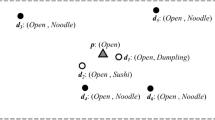Abstract
With the popularity of mobile devices and the development of geo-positioning technology, location-based services (LBS) attract much attention and top-k spatial keyword queries become increasingly complex.It is common to see that clients issue a query to find a restaurant serving pizza and steak, low in price and noise level particularly.However, most of prior works focused only on the spatial keyword while ignoring these independent numerical attributes.
In this paper we demonstrate, for the first time, the Attributes-Aware Spatial Keyword Query (ASKQ), and devise a two-layer hybrid index structure called Quad-cluster Dual-filtering R-Tree (QDR-Tree). In the keyword cluster layer, a Quad-Cluster Tree (QC-Tree) is built based on the hierarchical clustering algorithm using kernel k-means to classify keywords.In the spatial layer, for each leaf node of the QC-Tree, we attach a Dual-Filtering R-Tree (DR-Tree) with two filtering algorithms, namely, keyword bitmap-based and attributes skyline-based filtering. Accordingly, efficient query processing algorithms are proposed.
Through theoretical analysis, we have verified the optimization both in processing time and space consumption. Finally, massive experiments with real-data demonstrate the efficiency and effectiveness of QDR-Tree.
This work was partly supported by the Program of International S&T Cooperation (2016YFE0100300), the China 973 project (2014CB340303), the National Natural Science Foundation of China (Grant number 61472252, 61672353, 61729202 and U1636210), the Shanghai Science and Technology Fund (Grant number 17510740200), CCF-Tencent Open Research Fund (RAGR20170114), and Guangdong Province Key Laboratory of Popular High Performance Computers of Shenzhen University (SZU-GDPHPCL2017).
Access this chapter
Tax calculation will be finalised at checkout
Purchases are for personal use only
Similar content being viewed by others
Notes
- 1.
Hereafter, Top-k is denoted as Top-\(\kappa \) to avoid confusion with the k-means algorithm.
References
Borzsonyi, S., Stocker, K., Kossmann, D.: The skyline operator. In: IEEE International Conference on 2002 Data Engineering (ICDE), pp. 421–430 (2002)
Cao, X., Cong, G., Jensen, C.S.: Retrieving top-k prestige-based relevant spatial web objects. Int. Conf. Very Large Data Bases (VLDB) 3, 373–384 (2010)
Chen, L., Gao, Y., Li, X., Jensen, C.S., Chen, G.: Efficient metric indexing for similarity search. IEEE Trans. Knowl. Data Eng. (TKDE) 29(3), 556–571 (2017)
Cong, G., Jensen, C., Wu, D.: Efficient retrieval of the top-k most relevant spatial web objects. Int. Conf. Very Large Data Bases (VLDB) 2(1), 337–348 (2009)
Cong, G., Jensen, C.S., Wu, D.: Efficient retrieval of the top-k most relevant spatial web objects. Int. Conf. Very Large Data Bases (VLDB) 2(1), 337–348 (2009)
Dhillon, I.S., Guan, Y., Kulis, B.: Kernel k-means: spectral clustering and normalized cuts. In: ACM SIGKDD International Conference on Knowledge Discovery and Data Mining (KDD), pp. 551–556 (2004)
Felipe, I.D., Hristidis, V., Rishe, N.: Keyword search on spatial databases. In: IEEE International Conference on Data Engineering (ICDE), pp. 656–665 (2008)
Lee, J., Hwang, S.: Toward efficient multidimensional subspace skyline computation. Int. Conf. Very Large Data Bases (VLDB) 23(1), 129–145 (2014)
Li, Z., Lee, K.C., Zheng, B., Lee, W.C., Lee, D., Wang, X.: Ir-tree: an efficient index for geographic document search. IEEE Trans. Knowl. Data Eng. (TKDE) 23(4), 585–599 (2011)
Liu, X., Chen, L., Wan, C.: LINQ: a framework for location-aware indexing and query processing. IEEE Trans. Knowl. Data Eng. (TKDE) 27(5), 1288–1300 (2015)
Ma, G., Arefin, M.S., Morimoto, Y.: A spatial skyline query for a group of users having different positions. In: Third International Conference on Networking and Computing, pp. 137–142 (2012)
Mikolov, T., Chen, K., Corrado, G., Dean, J.: Efficient estimation of word representations in vector space. Computer Science (2013)
Qian, Z., Xu, J., Zheng, K., Sun, W., Li, Z., Guo, H.: On efficient spatial keyword querying with semantics. In: Navathe, S.B., Wu, W., Shekhar, S., Du, X., Wang, X.S., **ong, H. (eds.) DASFAA 2016. LNCS, vol. 9643, pp. 149–164. Springer, Cham (2016). https://doi.org/10.1007/978-3-319-32049-6_10
Qian, Z., Xu, J., Zheng, K., Zhao, P., Zhou, X.: Semantic-aware top-k spatial keyword queries. World Wide Web (WWW), pp. 1–22 (2017)
Ray, S., Nickerson, B.G.: Dynamically ranked top-k spatial keyword search. In: ACM International Conference on Management of Data (SIGMOD), pp. 6–18 (2016)
Sasaki, Y., Lee, W.-C., Hara, T., Nishio, S.: Sky R-tree: an index structure for distance-based top-k query. In: Bhowmick, S.S., Dyreson, C.E., Jensen, C.S., Lee, M.L., Muliantara, A., Thalheim, B. (eds.) DASFAA 2014. LNCS, vol. 8421, pp. 220–235. Springer, Cham (2014). https://doi.org/10.1007/978-3-319-05810-8_15
Tao, Y., Sheng, C.: Fast nearest neighbor search with keywords. IEEE Trans. Knowl. Data Eng. (TKDE) 26(4), 878–888 (2014)
Zhang, C., Zhang, Y., Zhang, W., Lin, X.: Inverted linear quadtree: efficient top k spatial keyword search. In: IEEE International Conference on Data Engineering (ICDE), pp. 901–912 (2013)
Author information
Authors and Affiliations
Corresponding author
Editor information
Editors and Affiliations
Rights and permissions
Copyright information
© 2018 Springer Nature Switzerland AG
About this paper
Cite this paper
Zang, X., Hao, P., Gao, X., Yao, B., Chen, G. (2018). QDR-Tree: An Efficient Index Scheme for Complex Spatial Keyword Query. In: Hartmann, S., Ma, H., Hameurlain, A., Pernul, G., Wagner, R. (eds) Database and Expert Systems Applications. DEXA 2018. Lecture Notes in Computer Science(), vol 11029. Springer, Cham. https://doi.org/10.1007/978-3-319-98809-2_24
Download citation
DOI: https://doi.org/10.1007/978-3-319-98809-2_24
Published:
Publisher Name: Springer, Cham
Print ISBN: 978-3-319-98808-5
Online ISBN: 978-3-319-98809-2
eBook Packages: Computer ScienceComputer Science (R0)




